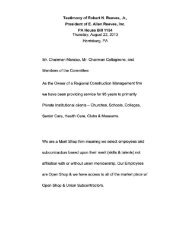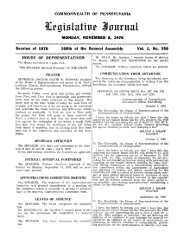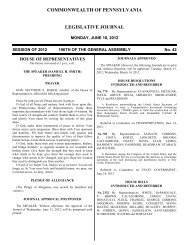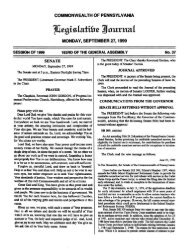Statement of Ronald B. Herberman, MD Chairman of Board ...
Statement of Ronald B. Herberman, MD Chairman of Board ...
Statement of Ronald B. Herberman, MD Chairman of Board ...
You also want an ePaper? Increase the reach of your titles
YUMPU automatically turns print PDFs into web optimized ePapers that Google loves.
IpsilateraI/Contralateral Data (tumor same sidelopposite from where cellphone was held, Table<br />
5)<br />
Many other studies have found a clear association between side <strong>of</strong> head on which phone use was<br />
generally reported and location <strong>of</strong> brain tumor, referred to as ipsilateral association.<br />
Analysis <strong>of</strong> the reported data in this study found an increased ipsilateral or contralateral risk <strong>of</strong><br />
brain tumors in most cases and nearly half (46%) <strong>of</strong> these results that were statisticaIly<br />
significant or borderline statistically significant. Eight data trends were reported, and seven <strong>of</strong><br />
these showed increasing risk with increasing exposure and were either statistically significant or<br />
borderline significant. With a five-fold increased risk <strong>of</strong> brain cancer in children contained<br />
within these trends, it is hard to imagine how this did not grab the attention <strong>of</strong> the authors and the<br />
edito~% <strong>of</strong> the JNCI.<br />
At first glance, because the ipsilateral risks found in this study are smaller than the ccntralated<br />
risks, there appears to be something wrong. The most likely explanation is that the reported<br />
laterality was not consistent with the use. Nevertheless these results indicating increased risk for<br />
brain cancer are <strong>of</strong> major concern.<br />
Among the possible expladations for Why holding a phone on the opposite side <strong>of</strong> the head from<br />
the tumor, where very little cellphone radiation was absorbed results in a greater iisk compared<br />
to holding the cellphone on the same side <strong>of</strong> the head where almost a11 <strong>of</strong> the cellphone radiation<br />
was absorbed, are:<br />
1, There are more brain tumor cases (215in the "Central or unknown location" than in either<br />
the ipsilateral (208) or contralateral (190) results. The lack <strong>of</strong> tumor location data is a<br />
major flaw in this report, and such key data should have been available from hospital<br />
records.<br />
2. Ipsilateral use is defined in the study as "predominately on same side <strong>of</strong> head, or both<br />
sides <strong>of</strong> head." StFangely a footnote implies all <strong>of</strong> these data should have been e~cluded.~<br />
3. Contralateral use is defined in the study as "mostly on side opposite the tumor."'<br />
4. Ipsilateral, contralateral and central or unknown locations are mutually exclusive<br />
categories, yet when the cases in each category are summed, the total is substantially<br />
larger than the number <strong>of</strong> cases (613 compared to 352). No explanation is provided.<br />
The study's definitions <strong>of</strong> ipsilateral and contralateral use differ from dictionary definition^,^ and<br />
from those employed in all previous cellphone studies.<br />
' "All matched sets in whtch the case patient andior the control subject was a regular conmlateral user were<br />
excluded fiom the ipsilateral analyses; similarly, sets in which the case patient andlor the control subject was a<br />
re@laripsilateral user were excluded from the contralateral analyses." [Emphasis added]<br />
Ipsilateral. ''s~tuated or appearing on or affecting the same side <strong>of</strong> the body;" Contralateral: "occurring on oractAhg<br />
in conjnnction with a pa^ on the oppositeslde<strong>of</strong>the body." /5]












